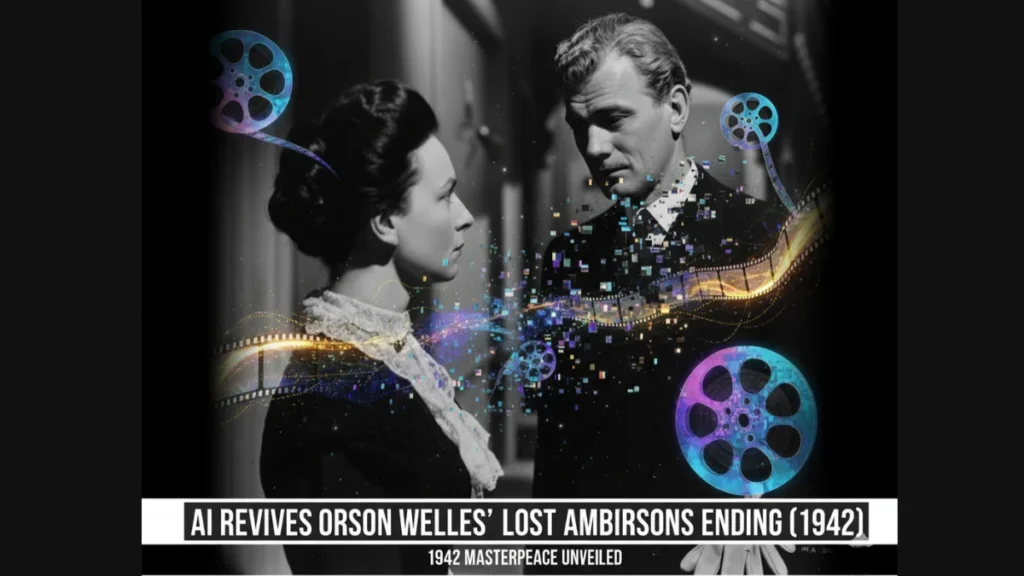The holy grail of lost cinema is getting an AI resurrection.
Showrunner, the controversial AI studio behind unauthorized South Park episodes, is teaming with film historian Brian Rose to digitally reimagine the 43 missing minutes from Orson Welles’ The Magnificent Ambersons. The project promises to push the boundaries of both cinephile obsession and generative filmmaking.
Key Takeaways
- Showrunner’s FILM-1 AI will attempt to recreate Welles’ lost ending.
- 43 minutes of Ambersons were destroyed after studio cuts in 1942.
- Project blends AI keyframe generation, live actors, and face transfer.
- Welles once said the original film could have eclipsed Citizen Kane.
- Restoration is billed as a noncommercial academic experiment.
Showrunner is using its FILM-1 AI model to digitally reconstruct the missing 43 minutes of Orson Welles’ The Magnificent Ambersons. Partnering with film historian Brian Rose, the project combines AI-generated keyframes, set photos, and live actors. While noncommercial, it aims to test AI’s role in restoring lost cinema classics.
A Lost Masterpiece Meets AI
For cinephiles, the missing footage of Orson Welles’ 1942 drama The Magnificent Ambersons has long been a source of obsession. The film was slashed from 131 minutes to 88 after a disastrous test screening. The excised reels — believed by Welles to contain his finest work — were melted down for their silver nitrate.
Now, more than 80 years later, Showrunner, the AI-first streaming startup, is betting it can conjure those missing scenes back into existence. Using its new FILM-1 model, the company plans a two-year project blending artificial intelligence with historical research to approximate what Welles’ original vision might have been.
From Charcoal Sketches to Generative Cinema
Showrunner is working with Brian Rose, a scholar who has spent half a decade trying to reconstruct Ambersons using charcoal storyboards, scale models of sets, and script drafts. Rose’s painstaking work provides the scaffolding for FILM-1 to build upon.
The AI will generate keyframes for major shots, using motion and trajectory modeling to emulate Welles’ signature camera moves. Surviving set photographs will help recreate the spatial design. Some scenes will be staged with live actors, then digitally altered with AI-driven face and voice transfers.
“Perhaps in its reconstructed form, we will all say, in the words of an audience card at the disastrous preview in Pomona: ‘I think that this is the best picture that I have ever seen,’” Showrunner CEO Edward Saatchi told IndieWire.
Why This Matters for Cinema and AI
To many purists, the idea of using AI to “finish” Welles’ film borders on sacrilege. Yet Saatchi argues the symbolism is too powerful to ignore: Ambersons itself is about a wealthy family undone by their refusal to adapt to technological change.
“If you’re going to train an AI model, why not train it on the best?” Saatchi asked. “So many people are rightly skeptical of AI’s impact on cinema — but we hope this shows how it can make a positive contribution to storytelling.”
For Showrunner, which bills itself as the “Netflix of AI,” this project doubles as a high-profile training ground. FILM-1 is meant to unlock longer-form live-action stories on its platform, where users can already generate custom TV episodes through text prompts.
Industry Response and Rights Questions
The project is being described as a “noncommercial, academic” undertaking, shielding it from the legal pitfalls that plagued Showrunner’s AI-generated South Park episodes earlier this year. Warner Bros. owns the rights to Ambersons, while Concord holds derivative rights after acquiring the RKO film library.
For now, the AI restoration will not hit theaters or streaming services. But if the rights holders see potential in re-releasing a “restored” Ambersons, Saatchi says the team would welcome it.
The film community remains divided. Some celebrate the effort as a long-overdue attempt to honor Welles. Others fear it crosses a line into rewriting history with algorithms.
The Bigger Picture: A Test Case for AI Storytelling
Beyond film restoration, the Ambersons project foreshadows where generative video technology is heading. Saatchi envisions “playable” feature films that allow audiences to explore branching storylines within classic narratives.
Today’s AI models still struggle to maintain narrative coherence across feature-length films. But Showrunner believes FILM-1 could be a step toward what Saatchi calls “a scary, strange future of generative storytelling.”
Even skeptics agree on that much. The question is whether this experiment represents a bold act of cultural preservation — or a troubling new form of creative hubris.
Conclusion
Showrunner’s bid to resurrect Welles’ missing Ambersons ending is more than a cinephile’s dream. It’s a stress test for AI in filmmaking — raising the stakes in the debate over whether machines can preserve, extend, or distort artistic legacies.
